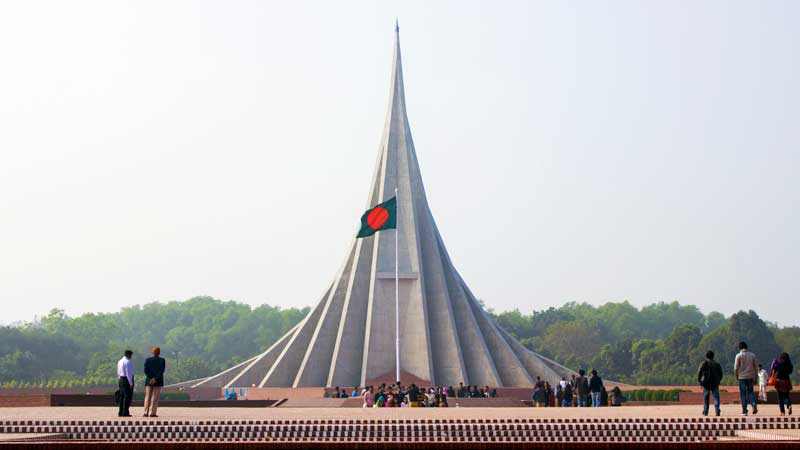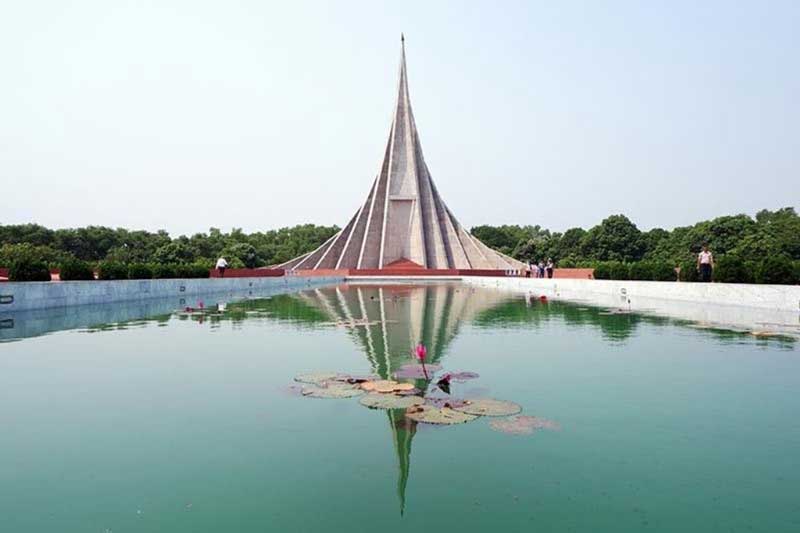
The National Martyrs' Monument, locally known as Jatiya Smriti Saudha, is located at Savar, an industrial suburb about 22 miles northwest of Dhaka in Bangladesh. Dedicated to the departed souls of the freedom fighters, who lost their lives during the Bangladesh Liberation War of 1971, the beautiful monument was inaugurated on 16 December 1982, eleven years after Bangladesh was separated from Pakistan to become a free, independent country.
The Plan for the construction of the monument was first initiated in 1972, when the government acquired nearly 110 acres of land for the project at a cost of Tk 26 lakh. While the main complex of the project required 84 acres of land, the remaining area was allocated for an aesthetic land-water greenbelt. After completing the access roads during the first phase, arrangements for the mass graves, helipads, parking spaces, and the pavements were constructed during the second phase, between 1974 and 1982. Construction of the monument, along with the associated greenbelt, and the cafeteria, was completed in the third phase, in 1982.

In the meantime, a nationwide design competition was held in June 1978, for the selection of an unquestionable and unanimous design for the proposed monument. Out of the 57 submitted designs, a heavyweight jury board, including the reputed architect Muzharul Islam, selected the design produced by a 26-year-old architect, Syed Mainul Hossain, as it perfectly expressed the aspiration of the new nation through an elemental composition of converging plates, achieving a sublime gesture of ascension.
The huge land-water greenbelt complex of the 150 feet tall National Martyrs’ Monument was designed as a comprehensive landscape, like a type of geometric tapestry weaving together the green areas, water bodies, pavements, and the walkways, all culminating at the high soaring monument. The basic plan associated with the monument is an arrangement of seven independent standing concrete plates, each of which is an isosceles triangle with two equal sides, but with different dimensions in height and base. This unique arrangement of the plates creates an optical illusion that seems to change its configuration when viewed from different angles. The winding passage that leads the visitors to the monument, gives them the opportunity to look at the monument from multiple perspectives, experiencing its dramatically changing configurations depending on the viewing location.

The seven plates of the monument are folded in the middle at a 90-degree angle. While the 150 feet tall highest plate, standing at the front, has the shortest base of 20 feet, the shortest plate, placed at the back, has the longest base measuring to 130 feet. The folded plates are placed one after another at an equal parallel spacing of 9 feet and 2 inches.
When looking at it from the front, this configuration creates two powerful parabolic curves rising majestically toward the sky. However, to a circumnavigating spectator, it presents only a singular frozen architectural expression, and from the side, the parabolic drama morphs into seven progressively rising triangles. Nevertheless, the feeling of ascension always remains constant.

The seven plates of the National Martyrs’ Monument is also the magic number that represents the seven important chapters in the history of Bangladesh, that includes the Language Movement in 1952, the victory of the United Front in the provincial election in 1954, the Constitution Movement in 1956, the movement against the Education Commission in 1962, the 6-point Movement in 1966, the massive mass uprising in 1969, and finally the War of Liberation in 1971, which culminated in the creation of Bangladesh as a free independent country.

The National Martyrs’ Monument that appears to touch the sky with its pointed tip, symbolizing the valour and sacrifice of the freedom fighters, is undoubtedly a beautiful architectural construction in Bangladesh.